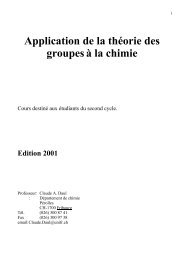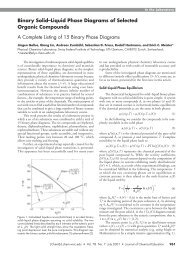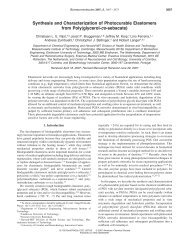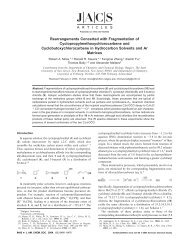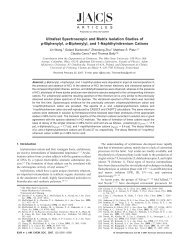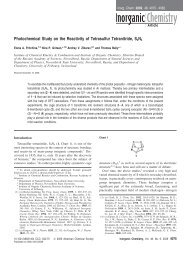Reversible Interconversion between Singlet and Triplet 2-Naphthyl ...
Reversible Interconversion between Singlet and Triplet 2-Naphthyl ...
Reversible Interconversion between Singlet and Triplet 2-Naphthyl ...
Create successful ePaper yourself
Turn your PDF publications into a flip-book with our unique Google optimized e-Paper software.
F J. Am. Chem. Soc. Zhu et al.Figure 6. Changes in the optical spectra on annealing a sample dopedwith 0.2% O 2 (a) after photodeazotation of MDA or (c) after >515-nm bleaching of the resulting sample. Spectra b <strong>and</strong> d show the resultof bleaching the broad 420-nm b<strong>and</strong> of spectrum a or c, respectively.is too small to be significant, so all one can say is that (E,E)-<strong>and</strong> (Z,E)-MDA should be present in similar amounts, whereasthe other two conformations will only be present in minutequantities. If no conformational changes take place on deazotation,a similar ratio should be found in the incipient tripletcarbenes, <strong>and</strong> the similar intensity within the pairs of ESR peaksindicates that this is effectively the case. As will be shownbelow, the presence of two rotamers manifests itself also in theIR spectrum of 3 NCC, albeit not as clearly as in the ESR spectra.2. <strong>Triplet</strong> 2-<strong>Naphthyl</strong>(carbomethoxy)carbene ( 3 NCC).From the experiments described in the Experimental Resultssection <strong>and</strong> past experience from similar cases, we can easilyassign the primary product of the photodeazotation of MDA tothe triplet state of 3 NCC: it shows the ESR signals of a triplet,has the sharp visible b<strong>and</strong>s typical of aromatic triplet carbenes,30,71 is trapped very efficiently by O 2 to form a carbonyloxide (λ max ) 420 nm) which can readily be photodecomposed,30,86 <strong>and</strong> reacts somewhat less efficiently with CO to givea ketoketene which is identified by its 1720- <strong>and</strong> 2100-cm -1b<strong>and</strong>s. 26,30,87,88INDO/S-CI calculations on 3 NCC reproduce the observedb<strong>and</strong>s at 590 (weak) <strong>and</strong> 360 nm (strong) reasonably well (Table2, Figure 7) <strong>and</strong> predict additional weak transitions which maybe responsible for the weak features observed at 430 <strong>and</strong> 410nm (Figure 1, spectrum b). (These weak features are obscuredin the difference spectrum due to the strong increase of thephotoproduct absorptions in this region.) Also, the IR spectrumcalculated for 3 NCC is in good agreement with the observedone. We will return to the issue of the IR spectrum after theconformational question discussed below is settled. At this point,it suffices to note that the “leading” IR b<strong>and</strong> of 3 NCC is that at1660 cm -1 (see Figures 2, 4, <strong>and</strong> 5), which vanishes <strong>and</strong>reappears entirely in concert with the sharp b<strong>and</strong>s in the visible.The aforementioned ESR spectra reveal the presence of twomajor conformational isomers of 3 NCC (Figure 3). On the basisof the differential behavior of these isomers under thermal <strong>and</strong>photochemical conditions, the ESR transitions can be assignedfor each conformer 89 <strong>and</strong> the zero-field splitting parameters can(86) S<strong>and</strong>er, W.; Kirschfeld, A.; Kappert, W.; Muthusamy, S.; Kiselewsky,M. J. Am. Chem. Soc. 1996, 118, 6508.(87) Toung, R. L.; Wentrup, C. Tetrahedron 1992, 48, 7641.(88) Clemens, R. J.; Witzeman, J. S. J. Am. Chem. Soc. 1989, 111, 2191.(89) Conformer A ((Z,Z)- 3 NCC): |D/hc| ) 0.437 cm -1 , |E/hc| ) 0.0357cm -1 ; Z 1 1208 G, X 2 4487 G, Y 2 5915 G, <strong>and</strong> Z 2 8074 G. Conformer B((E,Z)- 3 NCC): |D/hc| ) 0.415 cm -1 , |E/hc| ) 0.0397 cm -1 ; Z 1 954 G, X 24296 G, Y 2 5867 G, <strong>and</strong> Z 2 7839 G.; microwave frequency 9.510 GHz.Figure 7. Graphical representation of the results of INDO/S-CIcalculations on the excited states of 3 NCC. Black bars denote calculatedenergies <strong>and</strong> observed b<strong>and</strong> maximums (cf. Table 2 <strong>and</strong> Figure 1). Theleftmost column shows the composition of the excited states in termsof one-electron excitations involving the MOs depicted on the right.(Numbers in parentheses represent the calculated relative oscillatorstrengths.)Table 2. Excited-State Energies (∆E) <strong>and</strong> Oscillator Strengths (f)of 3 NCC a by INDO/S-CI bexcited state calcd ∆E,eV fexptl ∆E, eV(λ max, nm)2 3 A′′ 2.28 0.0001 2.10 (590)3 3 A′′ 3.21 0.0003 2.85 (435)4 3 A′′ 3.29 0.0021 3.06 (405)5 3 A′′ 3.57 0.0072 3.42 (362)6 3 A′′ 3.72 0.00037 3 A′′ 3.78 0.0564aAt the B3LYP/6-31G* geometry (see Figure 9). b Including singly<strong>and</strong> doubly excited configurations.be computed using the best fit of the observed ESR transitionsto the spin Hamiltonian. 90 In principle, 3 NCC might be expectedto display eight low-energy conformations arising from restrictedrotation about bonds a, b, <strong>and</strong> c in low-temperature matrixes(Chart 1). 25 In triplet carbenes with structural similarities to3 NCC, conformational isomers associated with restricted rotationabout bonds of types a <strong>and</strong> b, but not type c, 84 have beencharacterized by ESR spectroscopy. The model compounds2NC, 25,71,91,92 (4-nitrophenyl)carbomethoxycarbene, 28,31 <strong>and</strong> carbomethoxycarbene(CMC) 24,25 provide a framework for discussingthe triplet ESR spectra of 3 NCC. As expected, the D valuesof 3 NCC (0.437, 0.415 cm -1 ) are smaller than those of 3 2NC(0.493, 0.471 cm -1 ) because of the additional delocalizationprovided by the carbomethoxy substituent in 3 NCC. A similarrelationship is observed <strong>between</strong> the D values of (4-nitrophenyl)-carbomethoxycarbene (0.453 cm -1 ) 28,93 <strong>and</strong> (4-nitrophenyl)-(90) Wasserman, E.; Snyder, L. C.; Yager, W. A. J. Chem. Phys. 1964,41, 1763.(91) Trozzolo, A. M.; Wasserman, E.; Yager, W. A. J. Am. Chem. Soc.1965, 87, 129.(92) Senthilnathan, V. P.; Platz, M. S. J. Am. Chem. Soc. 1981, 103,5503.(93) The D value of the minor rotamer of triplet (4-nitrophenyl)-carbomethoxycarbene is not well determined. Only the X 2 <strong>and</strong> Y 2 transitionsof the minor rotamer were detected. To estimate the D value for this species,the authors assumed that the Z 1 <strong>and</strong> Z 2 transitions were coincident with thecorresponding transitions of the major rotamer




